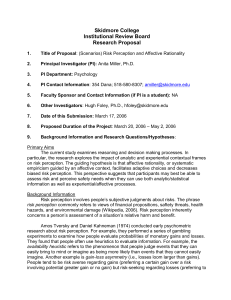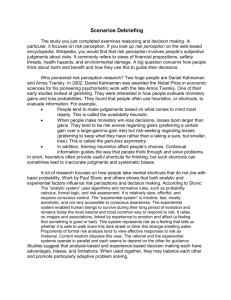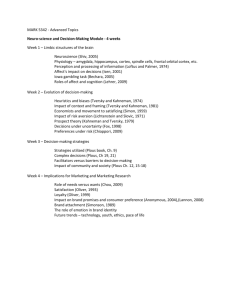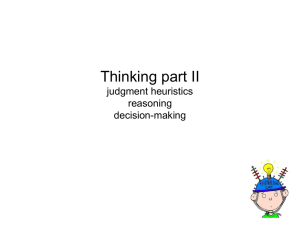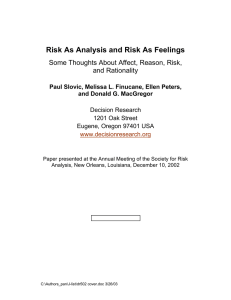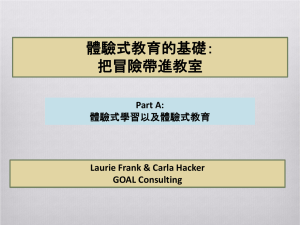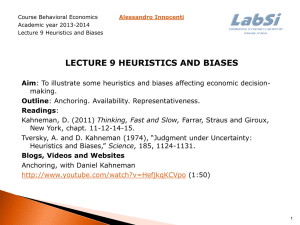Risk perception refers to people`s subjective judgments about risks
advertisement
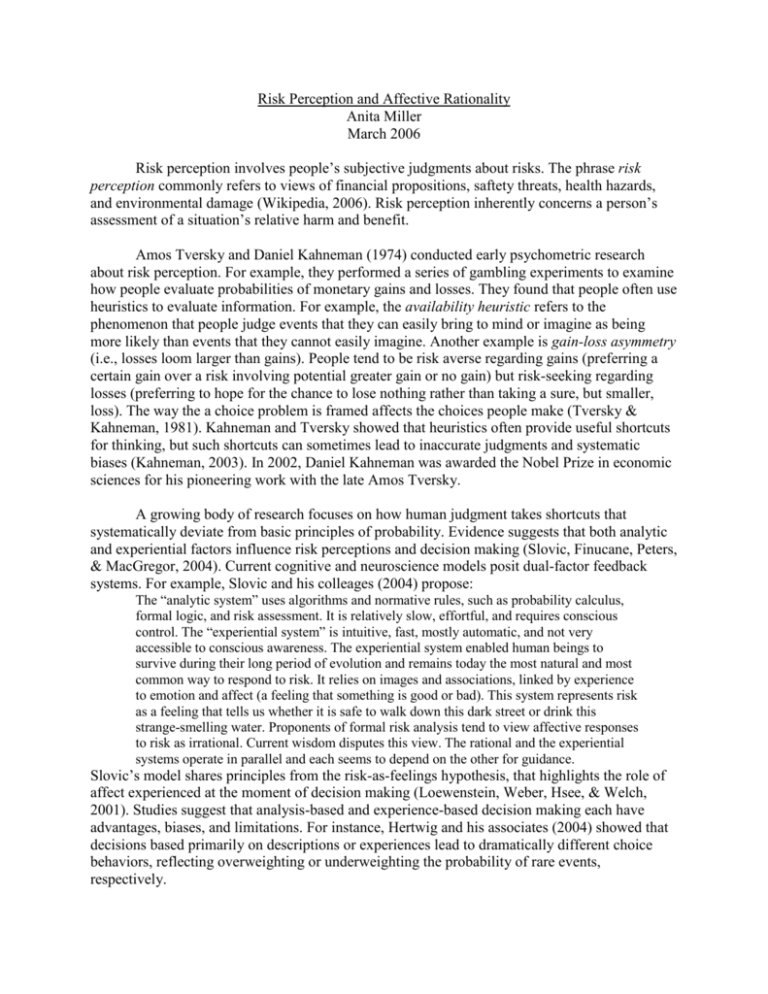
Risk Perception and Affective Rationality Anita Miller March 2006 Risk perception involves people’s subjective judgments about risks. The phrase risk perception commonly refers to views of financial propositions, saftety threats, health hazards, and environmental damage (Wikipedia, 2006). Risk perception inherently concerns a person’s assessment of a situation’s relative harm and benefit. Amos Tversky and Daniel Kahneman (1974) conducted early psychometric research about risk perception. For example, they performed a series of gambling experiments to examine how people evaluate probabilities of monetary gains and losses. They found that people often use heuristics to evaluate information. For example, the availability heuristic refers to the phenomenon that people judge events that they can easily bring to mind or imagine as being more likely than events that they cannot easily imagine. Another example is gain-loss asymmetry (i.e., losses loom larger than gains). People tend to be risk averse regarding gains (preferring a certain gain over a risk involving potential greater gain or no gain) but risk-seeking regarding losses (preferring to hope for the chance to lose nothing rather than taking a sure, but smaller, loss). The way the a choice problem is framed affects the choices people make (Tversky & Kahneman, 1981). Kahneman and Tversky showed that heuristics often provide useful shortcuts for thinking, but such shortcuts can sometimes lead to inaccurate judgments and systematic biases (Kahneman, 2003). In 2002, Daniel Kahneman was awarded the Nobel Prize in economic sciences for his pioneering work with the late Amos Tversky. A growing body of research focuses on how human judgment takes shortcuts that systematically deviate from basic principles of probability. Evidence suggests that both analytic and experiential factors influence risk perceptions and decision making (Slovic, Finucane, Peters, & MacGregor, 2004). Current cognitive and neuroscience models posit dual-factor feedback systems. For example, Slovic and his colleages (2004) propose: The “analytic system” uses algorithms and normative rules, such as probability calculus, formal logic, and risk assessment. It is relatively slow, effortful, and requires conscious control. The “experiential system” is intuitive, fast, mostly automatic, and not very accessible to conscious awareness. The experiential system enabled human beings to survive during their long period of evolution and remains today the most natural and most common way to respond to risk. It relies on images and associations, linked by experience to emotion and affect (a feeling that something is good or bad). This system represents risk as a feeling that tells us whether it is safe to walk down this dark street or drink this strange-smelling water. Proponents of formal risk analysis tend to view affective responses to risk as irrational. Current wisdom disputes this view. The rational and the experiential systems operate in parallel and each seems to depend on the other for guidance. Slovic’s model shares principles from the risk-as-feelings hypothesis, that highlights the role of affect experienced at the moment of decision making (Loewenstein, Weber, Hsee, & Welch, 2001). Studies suggest that analysis-based and experience-based decision making each have advantages, biases, and limitations. For instance, Hertwig and his associates (2004) showed that decisions based primarily on descriptions or experiences lead to dramatically different choice behaviors, reflecting overweighting or underweighting the probability of rare events, respectively. Affective rationality is a guiding principle of a dual-factor feedback system (DuFFS) model of risk perception. In particular, rational decision making may fundamentally involve integrated analytic and experiential feedback systems. Our brains may embody such interactive feedback mechanisms. On the one hand, the human brain contains a largely subcortical system for near instantaneous experiential responses to harm or benefit (LeDoux, 1996). In addition, a slower, more complex cortically-based system also processes information and prepares for actions. The cortical system contains a rich array of processing mechanims for representation, memory, expectancy, judgement, and language. The orbital prefrontal cortex uniquely integrates connections from sensory, motor, and visceral brain areas, and neurological patients with orbital frontal damage show marked affective reasoning deficits (Damasio, 1994). According to Damasio’s somatic marker hypothesis, the impaired decision making following orbital frontal lesions reflects damage to a system involved in learning how feelings signify experiential meaning. This essentially “tags” perceptual, motor, and symbolic representations with relevant visceral or somatic markers in order to guide thought and behavior. Such multi-modal parallel connections of the prefrontal cortex may provide mechanisms for analytic-experiential integration. In addition, neuromodulatory transmitters and hormonal processes may coordinate dynamic adaptive changes in more widespread brain areas. Regardless of the precise mechanisms, analytic-experiential interactions raise important practical challenges for adaptive problem solving (Slovic et al., 2004). How can integrated decision making, or affective rationality, inform novel approaches to risk management? One approach involves using affective rationality to promote accurate risk assessment. Purely emotional processes reflect an affect heuristic that can introduce biased assessments in come circumstances. For example, research documents that risks and benefits tend to be positively correlated in the world, suggested that many situations have the potential for both harmful and beneficial outcomes. However, people’s judgments of risk and benefit for specific situations are generally negatively correlated, reflecting dicotomous views (Fischhoff et al., 1978). Alhakami and Slovic (1994) showed that the inverse risk-benefit relation is linked to the strength of self-rated positive or negative affect about a target situation (e.g., using pesticides). In particular, if people report favorable feelings about a situation, then they are more likely to judge risk as low and benefits as high. However, if they report unfavorable feelings about an activity, then they tend to judge the opposite: high risk and low benefit (Slovic et al., 2005). Finucane et al. (2000) showed that the inverse relation bewteen perceived risks and benefits increases greatly under time pressure, when opportunities for analytic deliberation are reduced. Finucane also found that judgements of risk and benefit can be changed by providing information that modifies emotional appraisals of a situation. Such observations support the riskas-feelings hypothesis suggesting that affect can precede and direct judgments of risk and benefit. The capacity to change risk perception has practical implications. For example, Slovic and his colleaguse (2005) documented the importance of affective processes for comunicating the risks and benefits of cancer prevention actions and treatment options. Consistent with early work by Tversky and Kahneman (1981), framing influences the interpretation and use of information in decision making, and this principle can inform communicating with oncology patients about cancer screening and chemotherapy (Edwards, Enigwe, Elwyn, & Hood, 2003). The issue here is that such medical challenges inherently involve affective processes, and perhaps affect can be directed in a way that facilitates informed, adaptive problem-solving. Recent studies document that framing effects are relevant only to cognitive processes, but to affective processes as well. In fact, studies suggest that statistical information about health risks and benefits may have little meaning or utility (i.e., systematic biases persist) unless the information makes an affective connection in the patient (Slovic et al., 2005). An important goal for risk perception research is to understand how information can best be presented in a meaningful and useful way for making applied decisions and choices. The current study addresses this core goal with a 2x4 independent groups factorial design. The study includes 15 risk-related vignettes (e.g., cigarette smoking and cancer risks, stock investments and monetary risks), and participants make decision ratings on an 11-point scale. The target dependent variable is the aggregate self-rated decisions for each participant. One independent variable is Gender, and participants include equal numbers of males and females in each condition. The second independent variable is Framing, and the design includes four levels: The No-Frame condition includes target vignettes without a contextual frame. The Analytic-Frame condition includes the target vingnettes along with statistical risk information. The Experiential-Frame condition includes the target vingnettes along with vivid, affectladen scenarios with implied antecedents. The Analytic+Experiential-Frame condition includes both the statistical information and the affect-laden scenarios. The core guiding hypothesis is that participants will make the most adaptive choices in the analytic+experiential condition, relative to the other three conditions. The results have implications for understanding basic risk perception processes and for facilitating practial applications, such as health counseling and adovocacy. References Damasio, A. (1994). Descartes’ error: Emotion, reason, and the human brain. New York, NY: Penguin Putnam. Hertwig, R., Barron, G., Weber, E.U., & Erev, I. (2004). Decisions form experience and the effect of rare events in risky choice. Psychological Science, 15, 534-539. Kahneman, D. (2003). A perspective on judgment and choice: Mapping bounded rationality. American Psychologist, 58, 697-720. LeDoux, J. (1996). The emotional brain: The mysterious underpinnings of emotional life. New York, NY: Simon & Schuster. Loewenstein, G.F., Weber, E.U., Hsee, C.K., & Welch, N. (2001). Risk as feelings. Psychological Bulletin, 127, 267-286. Slovic, P., Finucane, M., Peters, E., & MacGregor, D.G. (2004). Risk as analysis and risk as feelings: Some thoughts about affect, reason, risk, and rationality. Risk Analysis, 24, 311-322. Slovic, P., Peters, E., Finucane, M.L., & MacGregor, D.G. (2005). Affect, risk, and decision making. Health Psychology, 24, S35-S40. Tversky, A., & Kahneman, D. (1974). Judgment under uncertainty: Heuristics and biases. Science, 185, 1124-1131. Tversky, A. & Kahneman, D. (1981). The framing of decisions and the psychology of choice. Science, 211, 453-458. Wikipedia (2006). Risk perception. Retrieved 3/13/06 from http://en.wikipedia.org/wiki/Risk_perception.
